Affiliate disclosure: This post may contain affiliate links. Please see our Privacy Policy.
Acorn flour is one of the most practical (and versatile) wild foraged flours available. Processing acorns into flour takes patience and work, but it’s downright delicious.
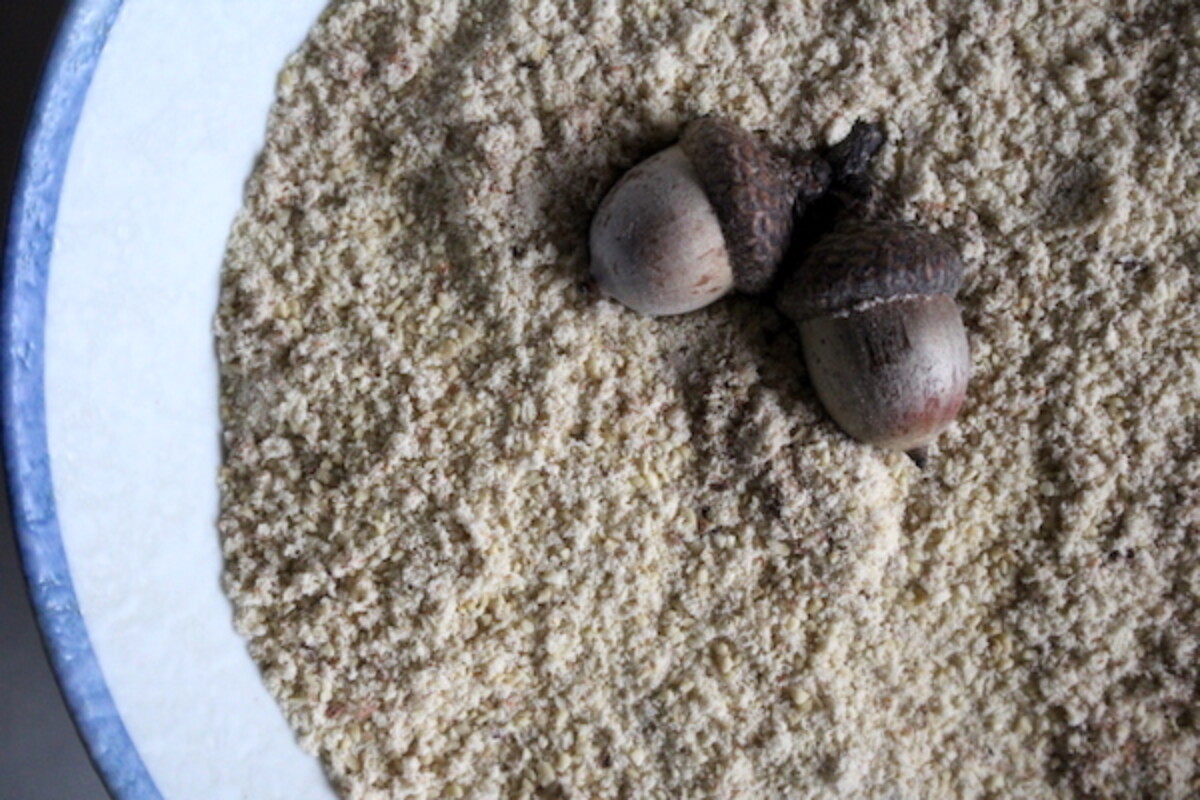
This past fall I set out to harvest as many acorns as possible, with the goal of making at least a dozen different acorn based recipes. Almost all of those recipes start with grinding and leaching the acorns into acorn flour.
Acorns contain natural tannins that must be leached from the nutmeats before they can be eaten, and the fastest way to remove the tannins is to create as much surface area as possible.
That means grinding the acorns into flour first, even if you’re not planning on making baked goods or acorn bread.
There are a number of ways to make acorn flour, and many different methods were used historically. Some involved using wood ash to bind the tannins, others leached the acorns whole in water-filled pits for months at a time, and still, other methods boil the acorns for hours on end.
Each of these methods has it’s pros and cons, and some manage to alter the flavor of the acorns and/or the structure of the starch within the nut (for better or worse).
Coldwater leaching is my preferred method, and it’s incredibly simple. It leaves you with the most versatile end product, with all the natural binding starches intact (for better bread) as well as the best flavor.
With the cold leach method, the starches within the acorn maintain their binding properties, and while there’s no gluten, it’ll still hold together well enough for pancakes, cookies, cakes, and even acorn pasta…
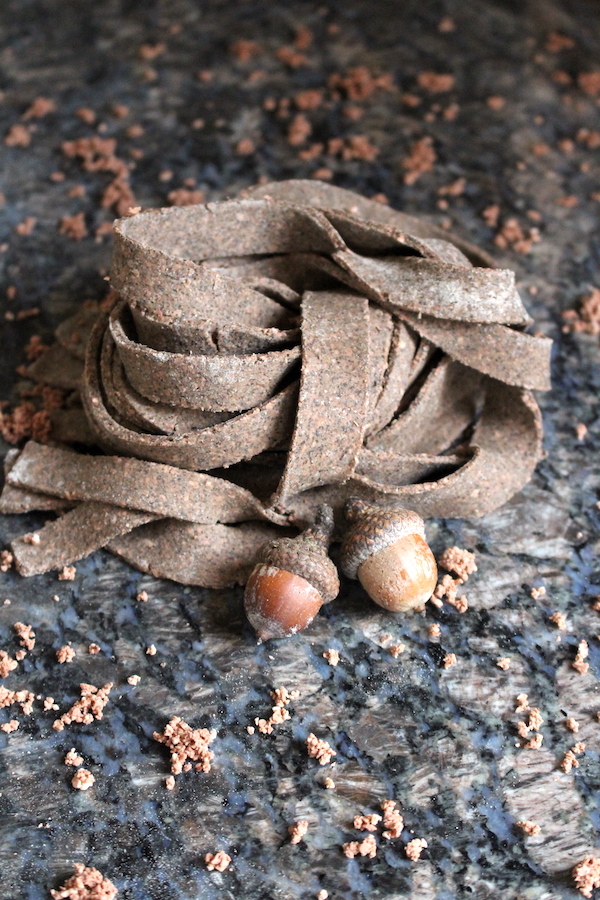
The cold leach method also happens to be the least labor-intensive method, requiring minimal work beyond patience (and acorn cracking).
(The only catch is, this method assumes you have plenty of fresh water available. In Vermont, we’re rather water-rich, but this may not be the best method for arid climates.)
How to Make Acorn Flour
The whole process starts with gathering the acorns. On a small scale, you can simply pick up acorns off the forest floor in the autumn. In urban and suburban environments, city parks are a good source, and you’d be amazed at how many public buildings landscape with oak trees.
Out here in the woods, it’s easy enough to rake them up by the bucketload.
(There is one commercial acorn flour manufacturer in Greece, and their founder wrote a book about their process titled Eating Acorns: A Field Guide. They place nets under the trees to gather the acorns more efficiently, and to prevent acorn weevils from infesting them before they’re gathered.)
Choosing Acorns to Harvest
There’s a myth that white acorns contain fewer tannins, which isn’t universally true. Some studies even show that some species of white acorns may have more tannins, but they’re just more tightly bound within the nutmeat and harder to leach properly.
White or red, it really doesn’t matter.
The best acorns to harvest are those that you can gather in quantity because you’re going to need at least a few gallons of nuts to make a meaningful amount of flour.
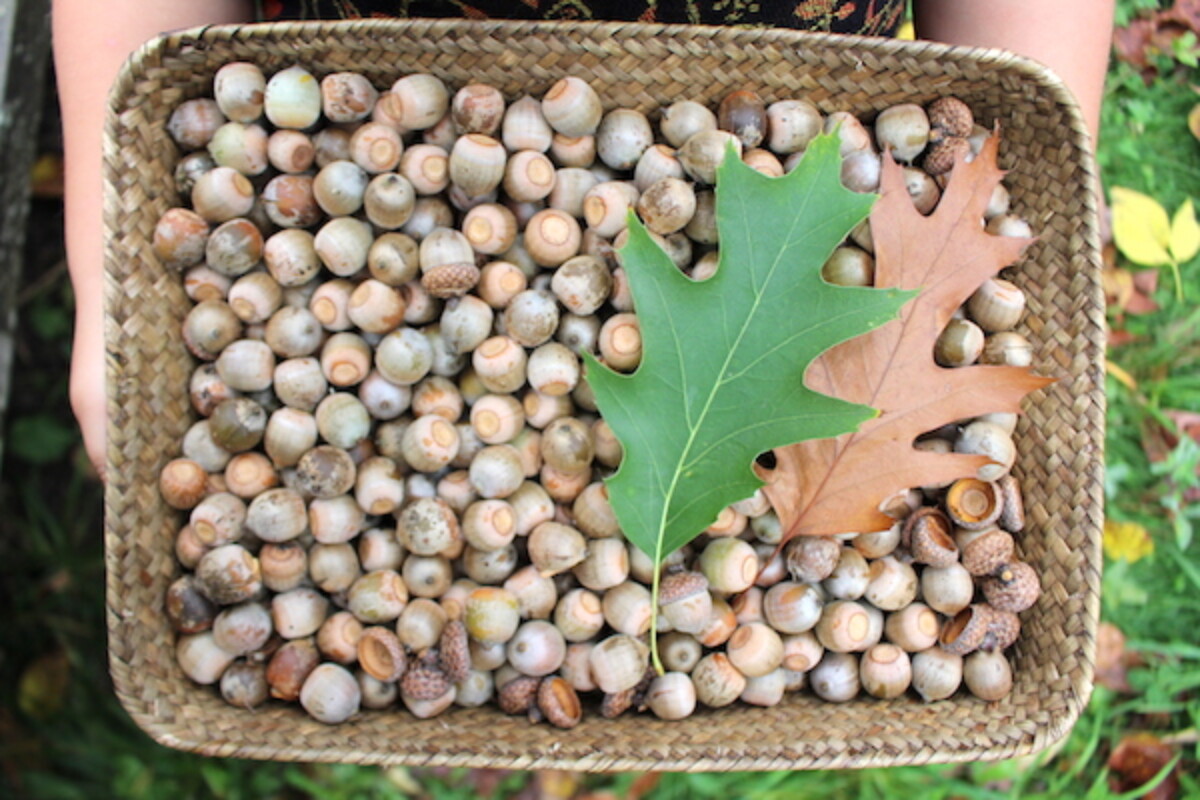
Cracking Acorns for Flour
Cracking acorns is where the real work starts. While you can rake up a bucket load of acorns in a few minutes, plan on spending hours cracking them. (If you’re doing it by hand.)
Historically, this would have been done by placing the acorn on a hard surface (like a rock) and then hammering it with another rock.
Setup at my kitchen table on a rainy fall evening, a cutting board and hammer works pretty well.
Through a lot of experimentation, I found that placing the acorn right side up (pointy end down) allows the point to dig into the cutting board when struck. That prevents the acorn from skidding out to the side, and ensure’s it cracks with one sharp blow.
(It’ll make a divot in your cutting board, so use one you don’t mind marking, and then that divot conveniently holds each of the rest as you crack them.)
Figure out what works best for you, as you’re going to be here a while.
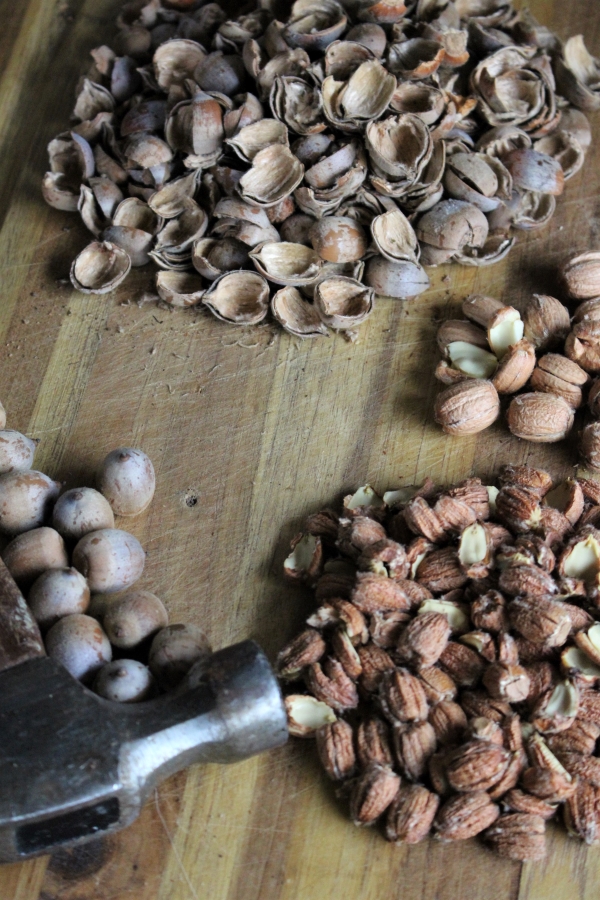
As you work, watch out for acorns with a hole in them. These acorns are no good, and have already been consumed by acorn weevils.
If you’re really adventurous, Pascal Baudar has recipes for protein-rich acorn weevils in his foraging book New Wildcrafted Cuisine.
So if your goal is “survival protein,” you can process these, otherwise, toss to the chickens and keep looking for clean acorns for flour.

Once cracked, the nuts are a lot more compact than they were in the shell.
I kept careful notes on yields…which I’ve since managed to lose. So a rough estimate, they’ll lose about 1/3 of their total volume in the cracking process.
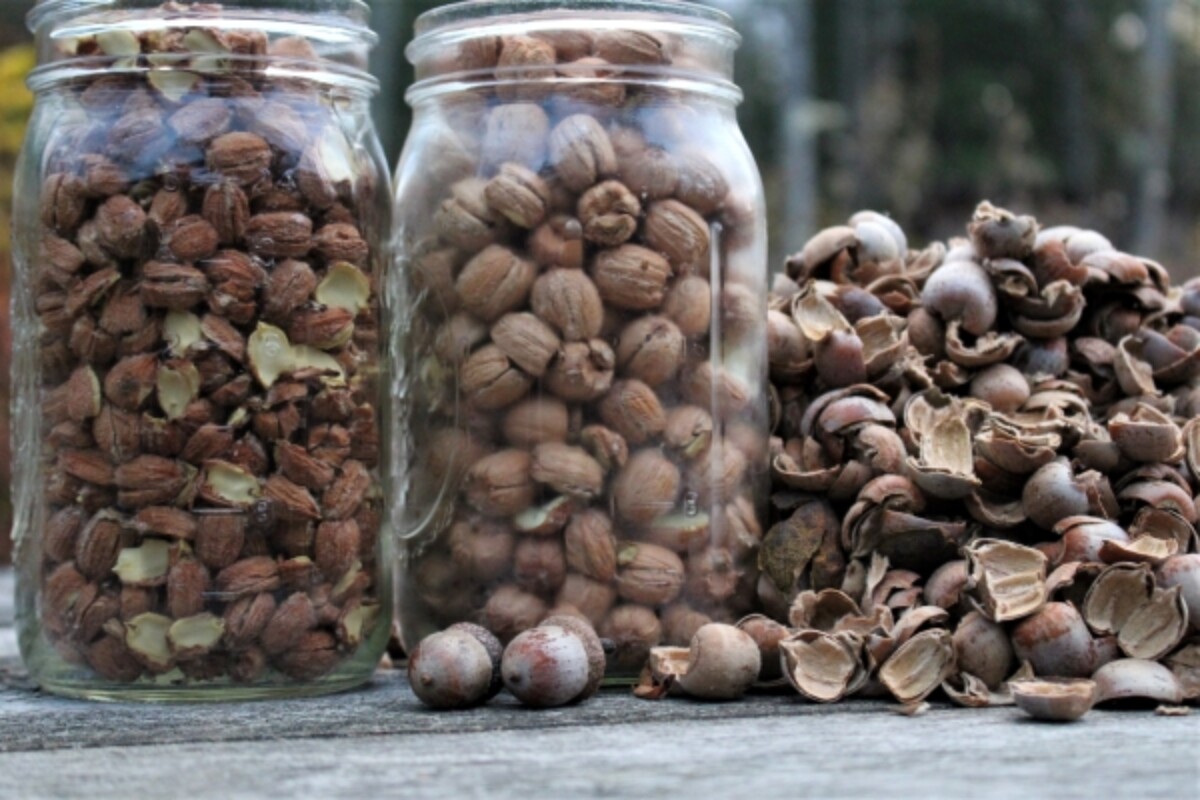
Grinding Acorns for Flour
Once you’re done cracking, it’s time to grind the nutmeats into flour.
This is a lot easier than cracking, especially if you’re willing to use a food processor or blender for the job. (Lacking that, you can pound them with rocks.)
Regardless of your grinding method, sift the flour out periodically as you work. You’ll be left with fine flour, as well as some larger “acorn grits” that you can either continue grinding or leach as is.
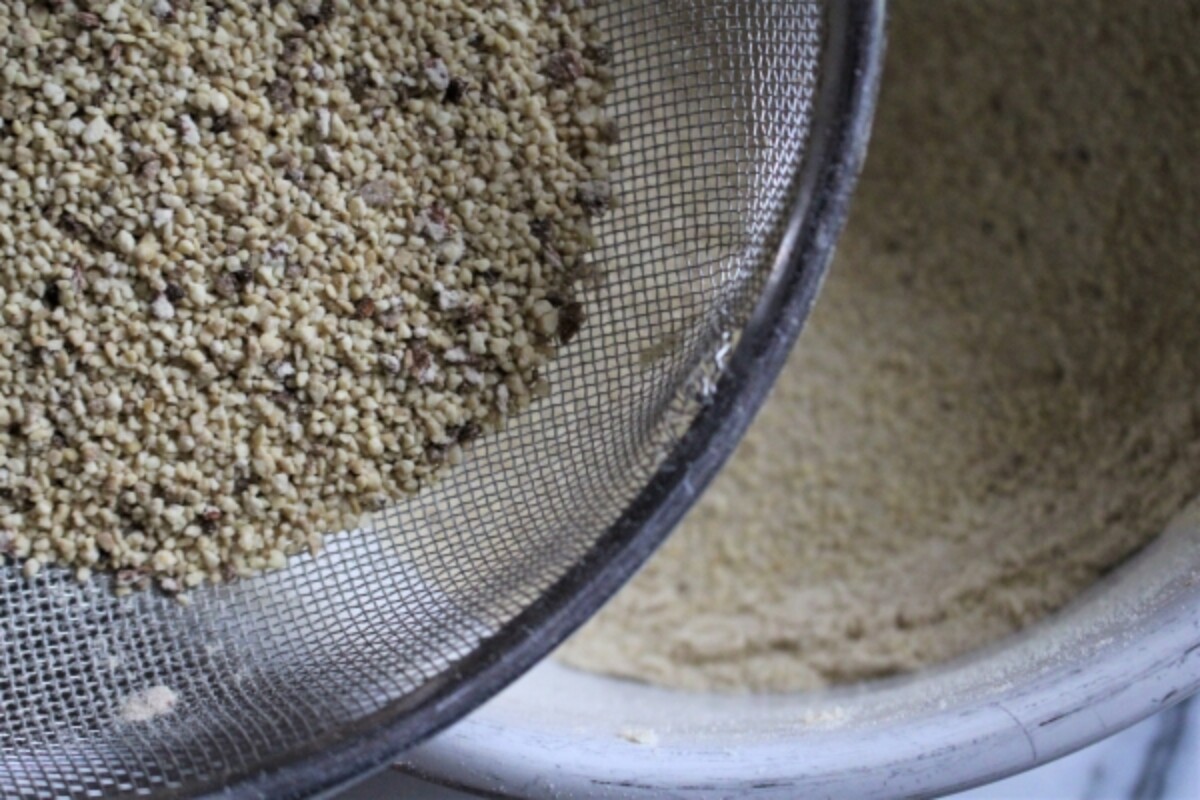
Leaching Acorn Tannins
Once ground, leaching acorn flour takes days of patience. It’s hands-off time, for the most part, all you’ll need to do is change the water every 12 hours or so.
Fill a container about 1/3 to 1/2 way with ground acorn flour. Fill the rest of the way with cool water, give it a shake, and then set it in some out of the way place (pantry, etc).
After about 6-12 hours, carefully pour the water off without disturbing the acorn flour settled at the bottom. Refill the container with clean water again and wait.
After about 2-3 days, you can begin tasting pinches of the acorn flour. When it’d ready, it’ll taste ever so slightly sweet with no hint of tannins.
If there’s even the tiniest taste of tannins in the flour, allow it to leach for more time. A hint in a tiny pinch means an inedible baked good once you’ve used cups of the stuff. This is important, make sure it doesn’t have any tannin taste.
Depending on the acorns, this process can take as long as 7-10 days with water changes every 12 hours.
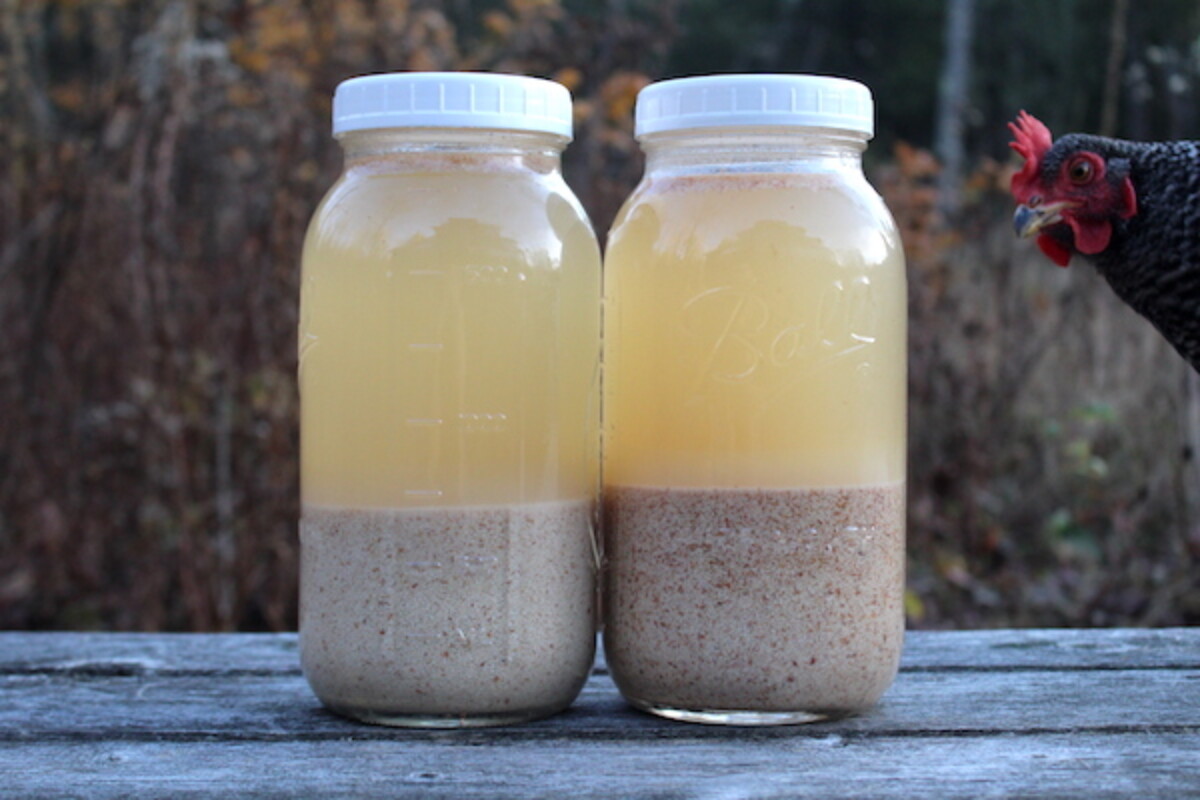
Drying Acorn Flour
Once you’ve leached the tannins from the acorn flour, it needs to be dried for storage and most uses.
Pour the flour through a piece of very fine mesh cheesecloth (90 grade) or something similar like an old (but clean) cotton t-shirt.
The resulting wet mass of “flour” can be used as-is in recipes, provided you reduce the rest of the liquid in the recipe slightly. It won’t keep long this way though and needs to be stored in the refrigerator.
Wet acorn flour has plenty of starch, and will bind together quite well after the cold process.
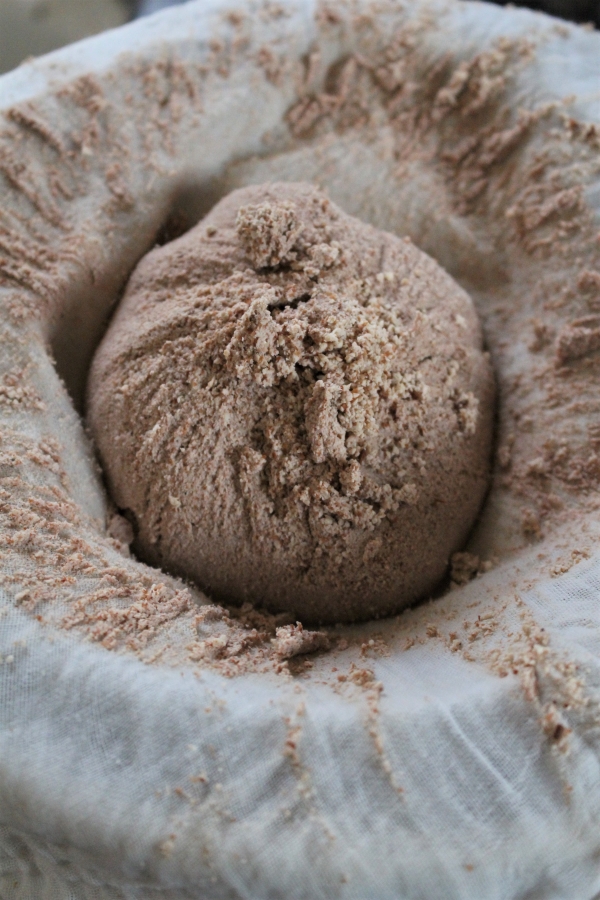
Storing Acorn Flour
Wet acorn flour will only last a week at best in the refrigerator, but it can be dried for long term storage.
I spread it on silicone sheets in my dehydrator, but you can also spread it out on trays in the sun for a more passive method. It’ll need to be stirred/turned every few hours to ensure it dries completely.
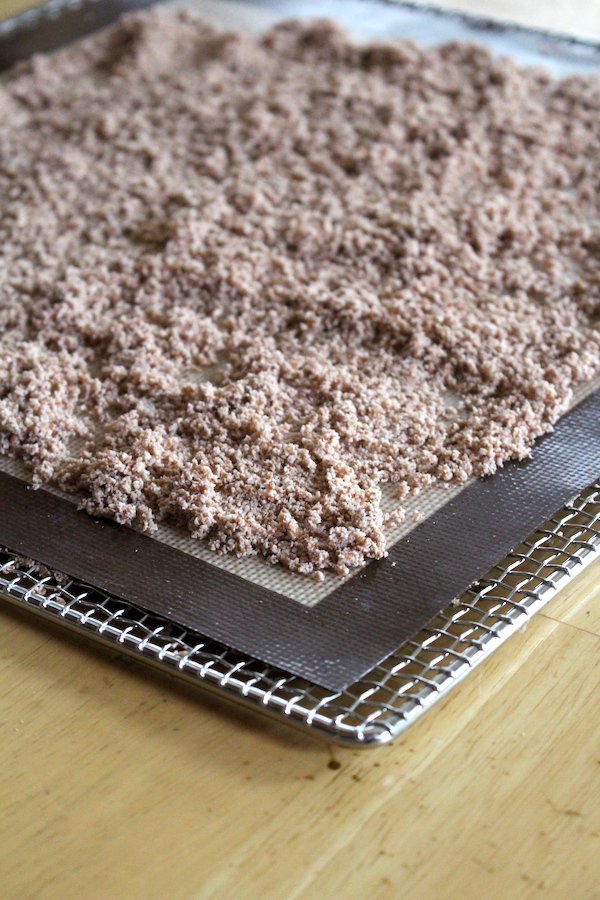
Once it’s completely dry, acorn flour will store a few months in the pantry (or a bit longer sealed in the fridge).
Keep in mind that acorn flour is a nut flour, similar to almond flour in some ways. It has healthy fats that add to its nutritional value, but can also go rancid over time.
It’s best for work in small batches, only processing as many acorns as you’ll eat in a month or two, and storing the rest of your harvest in the shell. As with most nuts, in the shell will keep quite well, and last much longer than processed acorn flour.
Cooking with Acorn Flour
Adapting white flour recipes to acorn flour can be a bit tricky, as it’s gluten-free flour. Instead, I’d suggest looking for recipes that include almond flour and make a 1:1 substitution.
Acorn flour also substitutes well for cornmeal.
It works wonderfully in cakes, pancakes, cookies, and quick bread (like banana bread).
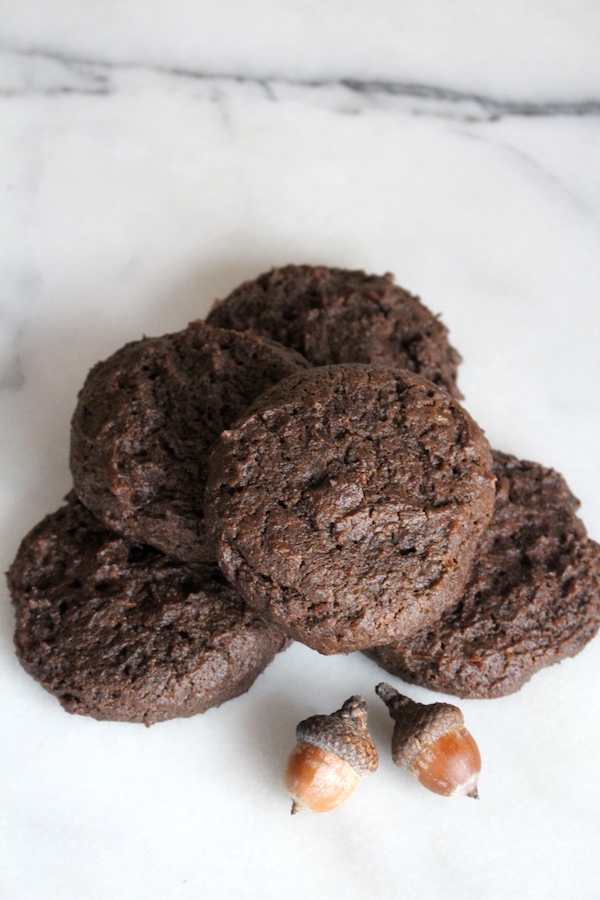
The one thing it won’t do? Make a fluffy yeast-risen sandwich bread. Without gluten for structure, acorn flour just can’t hold up to yeast leavening.
(That said, if you’re desperate for an acorn flour sandwich bread, it’s technically possible. If you’re willing to add xantham gum and all manner of other stuff that’s put in gluten-free bread, you might get something that’s almost fluffy and technically edible. It’d be a crime against the acorns in my book, but it’s your choice.)
We’ve used acorns to make all manner of things, from acorn pasta and cake, to acorn nut butter, ice cream, coffee, and more. I’m slowly getting the recipes for all that tastiness posted.
In the meantime, check out this article for more than 60 Acorn Recipes from around the world, with traditional preparations from Asia to Spain, the Middle East, and the Americas.
Other Acorn Flour By-Products
As a side note, this process yields more than just acorn flour. If you separate out the coarse ground acorn bits, you’ll end up with tasty acorn grits.
They still need to be leached, just like the fully ground flour, so follow the same process.
Acorn grits cook up just like oatmeal, with just a quick simmer in water, and they make a delicious hot breakfast cereal with a bit of maple syrup.
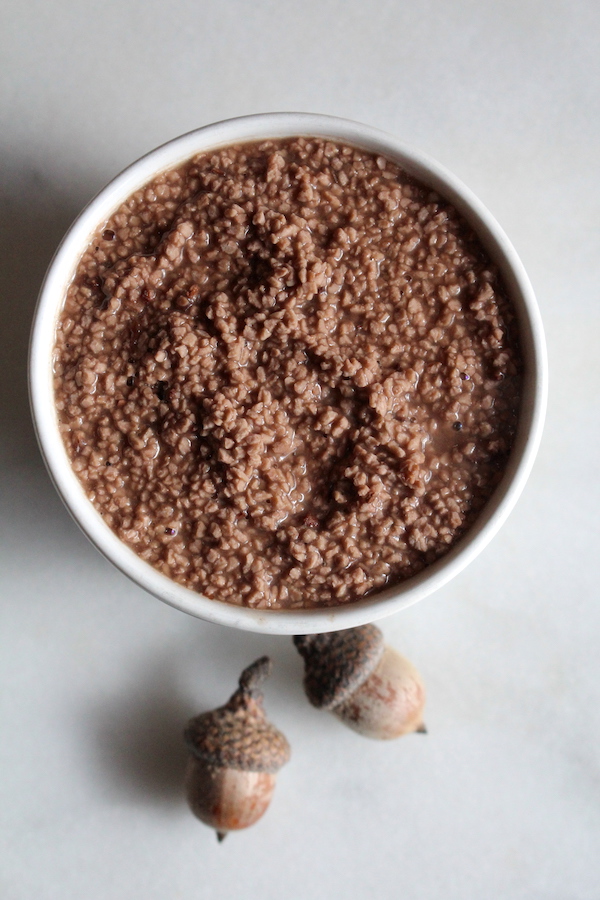
Beyond that, if you choose, you can separate out the very fine acorn starch. It’s the last to settle when you shake the water filled jars, so it’s easy to find at the top of a jar during the leaching process.
I leave it in the finished flour, but it’s traditionally used in Asian cooking. There are actually commercial acorn processing plants in Korea that make and package acorn starch for sale.
It’s used to make an acorn jelly known as dotori-muk, which is then cooked like tofu.
Acorn starch is also made into traditional noodles in place of other gluten-free starches, like rice starch.
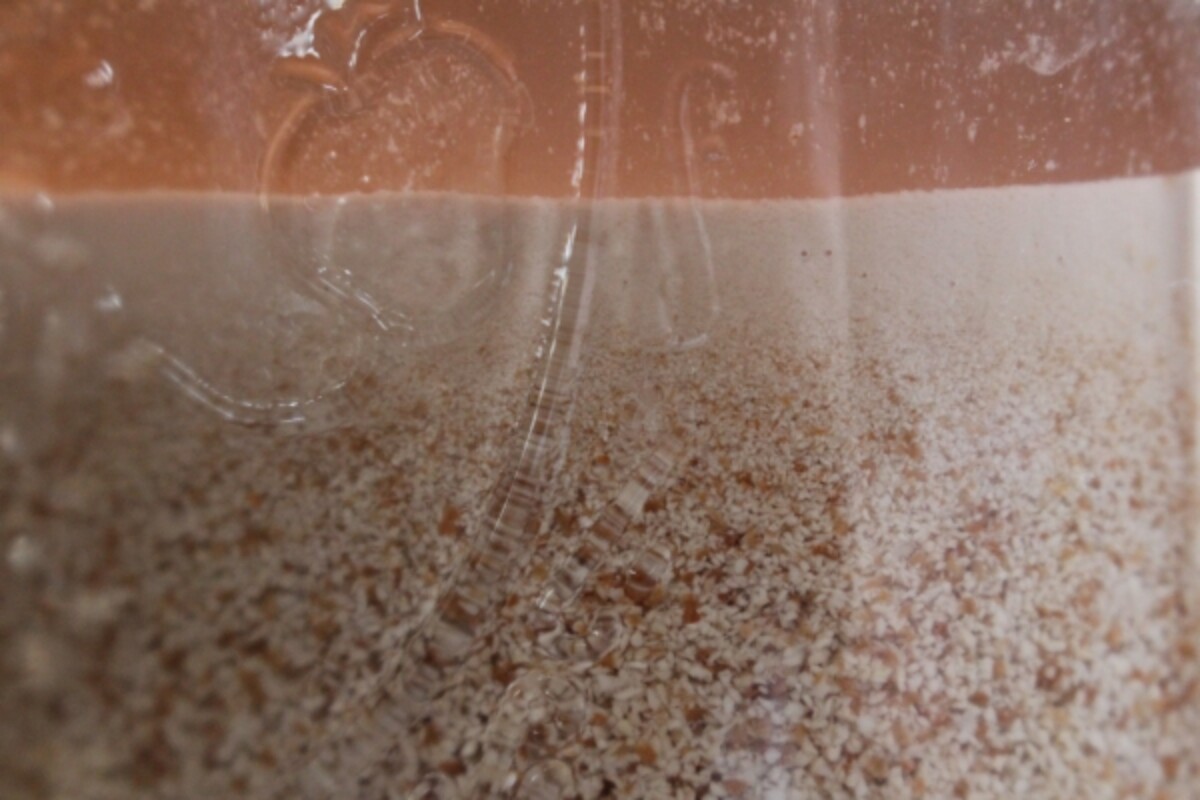
Foraging Tutorials
Hoping for more foraging tutorials? Read on…
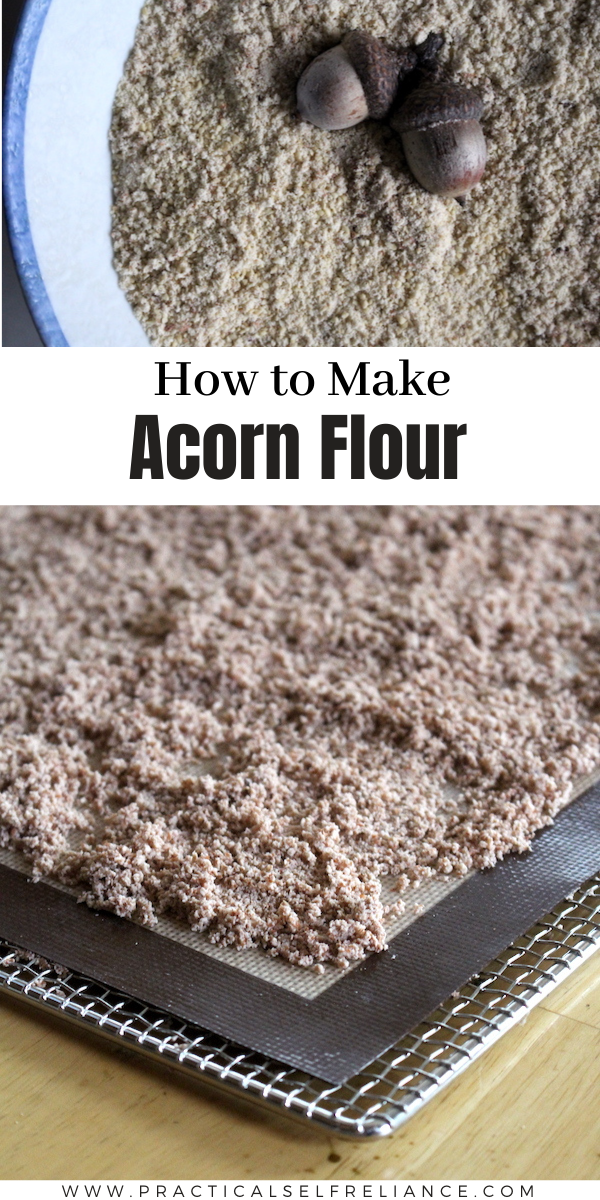














I have collected many buckets of acorns, but I do not have time to crack them all at once so I crack what I can as time allows. Can I keep the meat somewhere for a few days while I crack enough to process, or will they go bad?
Thank you for all the information you share, I use your articles all the time 🙂
I’m not sure to be honest. You could crack, grind and leach in small batches instead of waiting until they are all cracked to start grinding and leaching.
Hi Ashley! Your website is an excellent resource, especially for a newbie forager like me 🙂 How would you store and acorns in the shell if you don’t want to process them right away?
It’s actually best to gather them when they are green. You have a lower chance of them being infested by insects this way. Remove the cap and lay them out to dry in a single layer. Once they are dry, store them in the shell in a bucket with an airtight lid. Be sure to keep them dry.
Thank you so much for sharing your hard won knowledge
You’re very welcome. So glad you enjoyed the post.
I just finished my first batch of flour. I’ll be making Acorn/Cornmeal bread for dinner! Thanks Ashley. I’ll let you know how it turns out.
You’re welcome. We can’t wait to see how it turns out.
Now it know what to do with all these acorns all over my yard here in Texas. We have a lot of native oak trees on our property, as well as elm and beauty berry, so I’m learning what I can do with these. Sounds like pancakes with sticky elm syrup or beauty berry jelly. 😁
That’s awesome.
Ashley, you continue to provide wonderful articles, delicious ideas and practical ways of living, that I think we have lost/forsaken due to convenience. Thank you for patiently sharing the inspiring information
Peace Brian
You’re very welcome. I am so glad you enjoyed the post.
Linked over from your chocolate cookie post. This is a very helpful article and I just want to thank you for taking the time to put acorns thru trial and error process and then post this. I am aware of acorn flour as part of my foraging experience but have never tried because the info stated it was not worth the effort…indeed, it is called famine flour by one author. However, your method sounds fairly reasonable and doable to me.
I sometimes write a little article for our town newsletter. Not big enough for a paper…
If I write about this in the future, may I reference your website?
Pam
Thank you. I am so glad that you enjoyed the post and you can definitely reference the website.
Excellent information from you on acorn processing. We collected many bags of acorns in Northern Ca some of the biggest and best with way less tannin from our own yard. The shelling was tedious bot the leaching was donein about 3 days in water. Then into a convection oven to dry on a tray for an 1-2 hrs, grind into flour then mix with reg flour 50/50, table spoon of suger and the muffins are magnificient, pancakes too are very tasty. the soup with sausage very tasty.
Next batch of acorns will come from 4500′ elavation to test if there is a flavor difference. We really like the taste of acorn recipes
Thanks for sharing. So glad you enjoyed the post.
If your readers are NOT the adventurous types (and don’t want to eat weevils) I have an easy solution for them. I’m a forester in northern Wisconsin and we collect acorns by the scores of bushels to send to the nursery. Weevils are present in many of the acorns well before the nuts are ripe and are busy eating them from the inside out at harvest time. The solution? We simply dump all the acorns in a trough of water. Those that float are hollow (or are becoming hollow) on the inside. Those that sink are ready to go to the nursery! Bon appetit!
Thanks for the great tip!
Hi
If I cold leach the tannins, can acorn flour be eaten without being baked or cooked? Do you know?
sincverely
tyson
That is a darn good question…and I believe the answer is yes. So far as I know, there’s not a reason that you must cook acorns, only that you need to leech the tannins. I could be wrong about this, and I’m not completely certain, so use your best judgment, but to the best of my knowledge, there’s no reason not to. Maybe someone else has more definitive info on this, and if so, please join in on the comment thread.
Yes, it does still need to be brought to a boil and cooked.
Hey, I am Karuk (with Karuk/Yurok children) so I was raised gathering and processing acorns. A few things I thought I would add! One, when picking them up those with a “white butt” are usually best. You can dry them over the winter before cracking that way or dry afterwards. We can grind on rocks or with a hand crank grinder(make sure jt is not too fine, since we use it to make xuun, acorn soup). Then for leaching put them in a fine cloth so nothing goes through and we have a traditional leaching basket but even a colander would do, under it and set it in a sink (or rig up any water source) to allow it to drop through, overnight usually best! Then we dry it or freeze it, to be cooked with water and hot rocks but that’s different. Awesome to see other using and maintaining their oak trees!
Hi Francisca. Thank you so much for sharing your knowledge and experience with processing acorns with us! I’ll have to try some of your tips next year!
Hello! Love the recipes, your series on acorn in amazing and the info is incredible. You are a great source of inspiration 🙂
I have one question about your method to do flour. Are your acorns fresh or dried when your crack them and blend them? I am afraid my food processor wont be able to manage fresh nuts. Which stage are the nuts at when you start? Thanks!
You can do either, but they’re actually a good bit easier to get out of the shells if you allow them to dry for a few weeks before cracking. They shrink away from the shells as they dry. That’ll likely make it easier to process too, but I can’t say. The batch I did for this article was a mix of fresh and dried, which I noticed in the cracking, but they were mixed together for the grinding.
Ashley you rock! love your articles! love your personality as it shines through your posts! i definitely tell others about you – the real deal. Blessing to you and your family from Maine.
Thank you, and so glad to have you along =)
What can I say Ashley another great read I always wonted to try this lots of oaks around here I like the way you simplified the process will try. Thank you, Down under in N.H. Take Care.
So glad you enjoyed the article.
Fascinating! I’ve gathered acorns for decorating but never considered eating them. Now I have to go hit up our parks.
So glad you are going to try it!
Thank you for spending your precious time to share this valuable information. I live in Ma. and like your area, we have an abundance of oak trees and this year an abundance of acorns. I have always wanted to try making flour and now realize it isn’t as difficult as I previously thought.
One question, you recommend changing the water every 12 hours. When the fresh water is added, do you recommend the flour be stirred, or left undisturbed.?
Thank you and God Bless and keep you safe and Healthy.
You want to carefully pour off the water without disturbing the acorn flour on the bottom. You definitely don’t want to stir it.